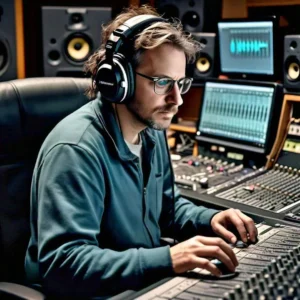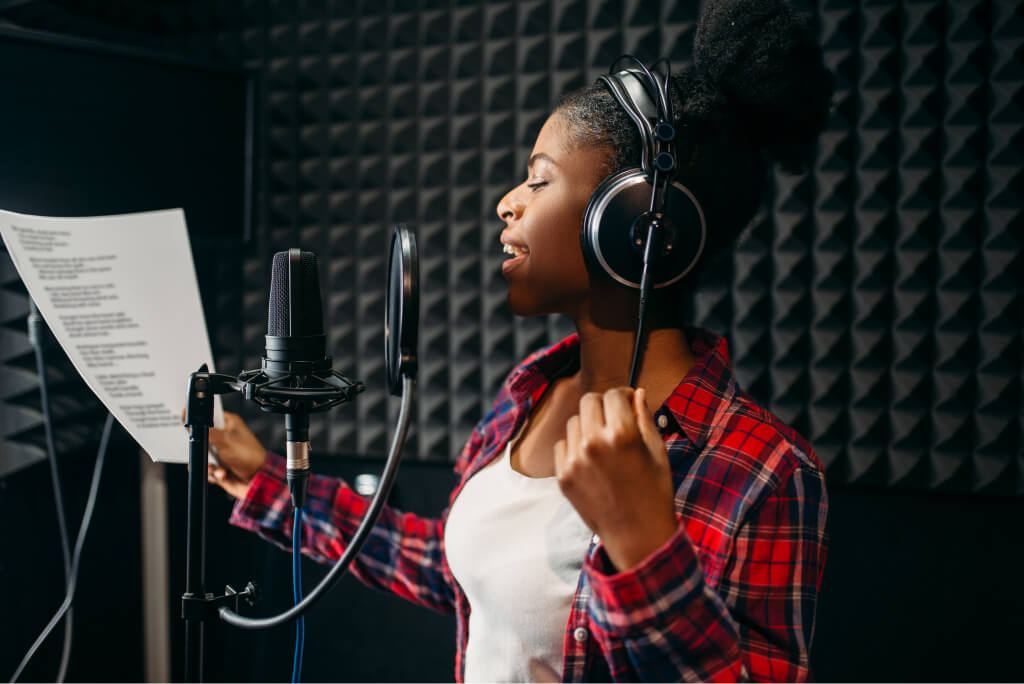Musicians
0
Albums Record
Hours Performance
1200
Studio Branch
0




Bring your voice to life with our state-of-the-art recording studio! Our expert engineers will guide you through the process, ensuring your voice sounds its best. From vocal coaching to post-production editing, we’ve got you covered.
– High-quality microphones and equipment
– Comfortable and soundproof recording booths
– Expert vocal coaching and direction
– Post-production editing and mixing
Whether you’re a singer, podcaster, or voiceover artist, our voice recording services will help you achieve professional-sounding results.





Take your audio to the next level with our expert sound mixing services. Our skilled engineers will balance, blend, and enhance your tracks to create a polished and professional sound.
– Multitrack mixing for music, podcasts, and voiceovers
– Stereo and surround sound mixing
– Noise reduction and audio restoration
– EQ, compression, and effects processing
– Mixing for various genres and styles
Let us bring clarity and depth to your audio!






Track mastering is the final step in the audio post-production process, where a mixed audio track is prepared for distribution and playback on various platforms. Here’s an overview:
What is Track Mastering?
Track mastering is the process of taking a mixed audio track and optimizing it for distribution, ensuring it translates well across different playback systems, formats, and media.
Goals of Track Mastering:
1. Loudness: Maximize the overall level of the track while maintaining a clear and balanced sound.
2. Clarity: Enhance the definition and detail of the audio, ensuring each element sounds clear and distinct.
3. Consistency: Ensure the track sounds consistent across different playback systems, formats, and media.
4. Translation: Prepare the track for distribution on various platforms, such as streaming services, CD, radio, and live performances.



Audio editing is the process of modifying and enhancing audio content to achieve a desired sound or quality. Here’s an overview:
What is Audio Editing?
Audio editing involves using software or hardware tools to manipulate audio recordings, correcting errors, and enhancing the overall sound.
Types of Audio Editing:
1. Corrective Editing: Fixing errors, removing noise, and correcting timing issues.
2. Creative Editing: Enhancing the audio to create a specific mood, atmosphere, or effect.
3. Mixing: Balancing levels, panning, and adding effects to create a cohesive mix.
Audio Editing Tasks:
1. Cutting: Removing unwanted parts of the audio.
2. Copying: Duplicating sections of the audio.
3. Pasting: Inserting copied audio into a new location.
4. Editing: Adjusting timing, pitch, and tone.
5. Arranging: Rearranging the structure of the audio.
Audio Editing Tools:
1. Latest : Software like Protools 24 Cubase 13 Pro and Logic Pro 11
2. Plug-ins: Software effects processors like reverb or compression.
3. Hardware: Audio interfaces, consoles, and outboard gear.
Audio Editing Applications:
1. Music Production: Recording, editing, and mixing music.
2. Post-Production: Editing audio for film, TV, and video games.
3. Podcasting: Editing and enhancing podcast episodes.
4. Voice-overs: Editing and refining voice-over recordings.
5. Drop out Abelton





What is Live Recording?
Live recording refers to capturing audio in real-time, typically during performances, events, or concerts. The goal is to preserve the energy and authenticity of the live experience.
Types of Live Recordings:
1. Concerts: Recording live music performances.
2. Theater: Capturing live plays, musicals, or other stage productions.
3. Public Speaking: Recording lectures, conferences, or presentations.
4. Events: Capturing audio for weddings, corporate events, or parties.
Live Recording Techniques:
1. Multitrack Recording: Capturing individual instruments or vocals on separate tracks.
2. Stereo Recording: Recording the overall sound using a pair of microphones.
3. Binaural Recording: Using a pair of microphones to create a 3D audio effect.
Live Recording Equipment:
1. Microphones: Dynamic, condenser, or ribbon microphones for capturing high-quality audio.
2. Audio Interfaces: Connecting microphones to recording devices or computers.
3. Mixing Consoles: Balancing levels and adjusting the mix in real-time.
4. Portable Recorders: Self-contained devices for capturing live audio.
Challenges of Live Recording:
1. Sound Quality: Dealing with varying acoustic environments and noise levels.
2. Equipment Failure: Minimizing technical issues during the recording.
3. Capturing the Performance: Preserving the energy and emotion of the live event.
Post-Production for Live Recordings:
1. Editing: Correcting errors and removing unwanted noise.
2. Mixing: Balancing levels and enhancing the overall sound.
3. Mastering: Preparing the final recording for distribution.
•Location Sound
•ADR (Dubbing)
•Dubbing Artists
•Dialog cleaning
•Foley
•SFX
•Mixing
•Stereo
•5.1
•7.1
•Atmos
•Mastering
•Video Editing
•DI (Color Correction)
•Lyrics
•Composing
•Arranging
•Recording
•Mixing
•Mastering

Consecte adipiscin elit, sed eiusmod tempor incididunt labore.

Consecte adipiscin elit, sed eiusmod tempor incididunt labore.

Consecte adipiscin elit, sed eiusmod tempor incididunt labore.